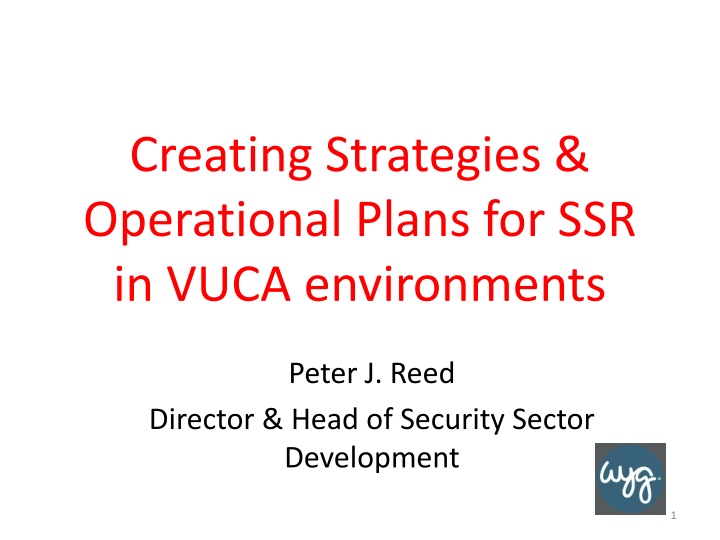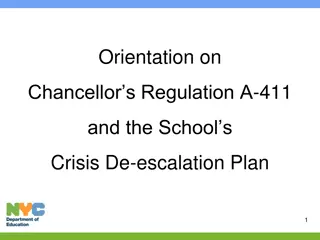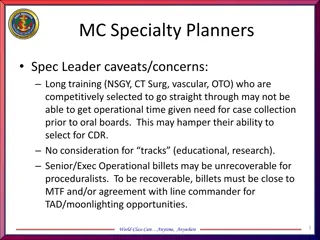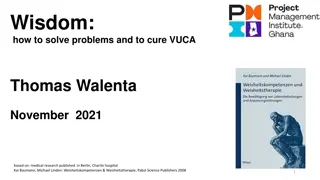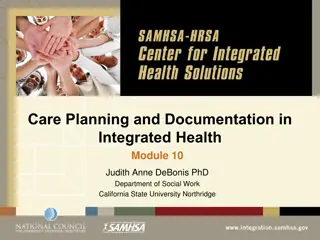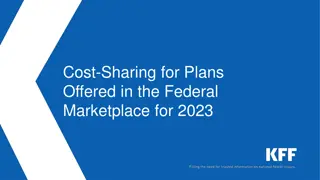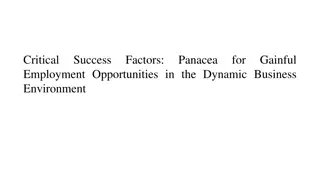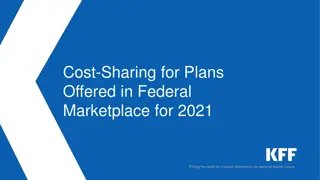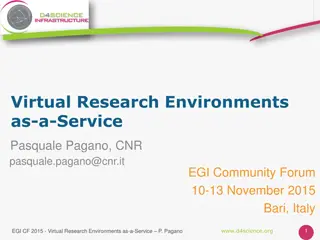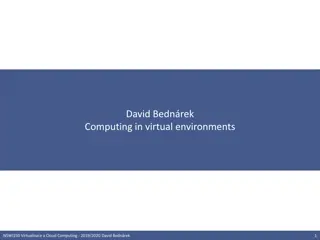Strategies & Operational Plans for VUCA Environments
Creating effective strategies and operational plans in volatile, uncertain, complex, and ambiguous environments is crucial for success. This involves translating data into actionable insights, reducing uncertainty, and leading through complexity with agility and clarity. The leadership implications highlighted encompass clear communication, flexibility, and the ability to see the bigger picture while supporting local teams.
Download Presentation

Please find below an Image/Link to download the presentation.
The content on the website is provided AS IS for your information and personal use only. It may not be sold, licensed, or shared on other websites without obtaining consent from the author.If you encounter any issues during the download, it is possible that the publisher has removed the file from their server.
You are allowed to download the files provided on this website for personal or commercial use, subject to the condition that they are used lawfully. All files are the property of their respective owners.
The content on the website is provided AS IS for your information and personal use only. It may not be sold, licensed, or shared on other websites without obtaining consent from the author.
E N D
Presentation Transcript
Creating Strategies & Operational Plans for SSR in VUCA environments Peter J. Reed Director & Head of Security Sector Development 1
The VUCA Operating Environment Characterised by: VOLATILITY UNCERTAINTY COMPLEXITY AMBIGUITY
The Desired End State We need to flip these to achieve VUCA insights: VISION (agreed by the leadership) UNDERSTANDING (by stakeholders) CLARITY (for those implementing) AGILITY (to permit flexibility) 3
VOLATILITY A state of dynamic instability brought about by drastic, violent, and rapid shifts; Problems no longer arise in the distance; they emerge without warning and require immediate attention and action. 4
Leadership Implications Translate data into information (the right data not just raw data), Communicate clearly (the small words are best!), Ensure your intent is understood (the end state describes what success will look like). 5
UNCERTAINTY It is human nature to see every challenge as something similar to what we've encountered before; But uncertainty becomes increasingly dangerous when we rush to understand it with only past experience; Uncertainty makes most people nervous. It is a leadership responsibility and task to reduce the level of uncertainty. 6
Leadership Implications Get a fresh perspective The View from the Balcony ; Encourage Red Teaming (Devil s advocates); Be flexible (plans never survive contact with the enemy so incorporate flexibility and options from the outset); Glance back but really look ahead (look for what can be done better in future rather than what should have been done in the past). 7
COMPLEXITY Threats and opportunities are not simply collective; we must see them as interactive. Leading through complexity means thinking non-linearly. The most important strategy competence is the ability to see the big picture and to support local leaders and their teams to achieve more together than they could individually. 8
Leadership Implications Stop seeking permanent solutions; Don t miss opportunities because you re obsessed with conquering the challenge; Manage expectations (yours, beneficiaries, donors); Opportunities exist in complexity seek them out; Concentrate on a manageable number of vital, do-able things; Good enough security for good enough governance! 9
AMBIGUITY Ambiguity results in inability to conceptualize threats and opportunities accurately before they become lethal; Increasing frustration that individual accomplishments don't add up to comprehensive or enduring success. It makes people insecure and can disrupt their ability to focus on the critical path. 10
Leadership Implications Provide clarity so that work assignments and goals are not as ambiguous as the environment; Provide clear direction and synchronise the efforts of others while continually communicating any adjustments to the plan; Listen well don t select just what you want to hear; Think divergently be open to new ideas; Create Quick Wins to demonstrate tangible progress and generate confidence. 11
Operationalising the Process Kotter s 8 Stages for Leading the Changes: Ensure the Sense of Urgency, Form or catalyse the Guiding Coalition Help them agree the Vision and End State Communicate, Communicate, Communicate! Programme the Approach for DIB, Create Quick Wins (don t just hope for them), Deepen and broaden the process, Consolidate the gains for momentum and critical mass. 12
Stepped process to influence change (based on Kotter s 8 stages) Impact Consolidation, integration, learning Programme changes incrementally Analyse gaps and create quick wins Design strategy/road map to desired state Assess current situation and capacity Clear vision, commitment and communication Building a powerful guiding coalition Prepare to lead the change sense of urgency Time 13
Additional Tools SWOT Analysis Against the PESTLE criteria, Against the VUCA Environment / Leadership criteria, Against the CAF Model criteria, The CAF Model To facilitate self-assessment of readiness of organisational Enablers for the DIB strategy, Balanced Scorecard Strategy Map, Showing logic for 4 perspectives of: Capacity Development & Learning, Key Process Improvement, Optimal use of finances (or new funding), Key Performance Results (Strategic Objectives) The Platforms Approach To phase and sequence implementation. 14
SWOT /PESTLE analysis (position assessment) Political Economic Social Technological Legal Environmental Strengths Weaknesses Opportunities Threats
Enhanced SWOT with capacity development enablers (capacity assessment) Strengths Weaknesses Opportunities Threats Enablers: Leadership Policy, Strategy and Plans Human Resources Management & Development Resources & Partnerships Processes Result Areas: Stakeholder / Client Satisfaction Employee Satisfaction & Motivation Impact of Policy Key Performance Results
Phased and sequenced approach in line with limited capacity For DIB in a conflict affected situation there are large number of tasks and actions required at multiple levels to contribute to stabilisation and effect lasting change. Somalia is no exception. But ability to do this is usually impacted by a large number of constraints. Limited absorption capacity Fractured communities & institutions Resource challenges Stability Security constraints Important in these situations that interventions are prioritised and sequenced in order to be manageable and mutually reinforcing. One way of doing this is to cluster interventions in a series of platforms prioritised and arranged in terms of both time and content
Sequencing through Platforms (Steps on a Staircase) Each platform adds value, but also builds to (and qualifies for) the next respecting limitations of capacity. Platform 4 (Interim 5 yr End State) Enables Platform 3 (3 years) Enables Platform 2 (1 year) Enables Platform 1 (Immediate) Activities at each stage selected based on contribution to platform objectives and to prepare the for progression to the next. Pr-requisite activities precede even Platform 1 (Prepare the ground / set the conditions) 19
The Process for the NSSP Somalia 2009-2011 01 October, 2009 : Meeting between the President and former senior military and security officials in Washington D.C Jan-Feb, 2011: Deployment of 18 security and military officials in Nairobi and Mogadishu : SSA report 2011 23 June, 2011 : Presentation, discussion and endorsement of the SSA reports of 2010 and 2011 July 2011 : Workshops with MoD, JHQ, MoI, NSA Staff to work up priorities (Bancroft) August 2011 : Preparatory workshops and Consultative meetings with Bancroft, UNPOS and Senior Military Officials Meeting in Washington DC August, 2011 : Constitute a Somali Strategic Planning Team and 12 - 16 August, 2011 : Organize the strategic planning retreat on the NSSP August, 2011: Briefing with the JSC on NSSP Progress, 22 August 2011 National Validation Trip to Regions and Workshop Sept to October, 2011
Programming Example (Somali DSP 2014-15) Activity Contribution to Platform Responsibility Timeline Draft Defence Strategic Plan and get Cabinet endorsement Provides basis for Donors Commitments SAT EUTM, MoD, OPM By August 2014 Develop DSP Component Operational Plans Provides work-plans and links to programmes and budgets Defence Working Group Sub- groups for planning, HR, Logistics, Force Devt. Ongoing by March 2015 Donors pledging conference Secure donor commitments and identify shortfalls OPM, MoD t.b.a. Conduct Functional Review of MoD and JHQ Define and rationalise functions, remove conflicts, Identify key HR deficits MoD, UNDP April 2015 21
Acknowledgements For VUCA original concept and acronym The US Army War College, Carlisle, PA. For VUCA descriptions and leadership insights Colonel Eric G. Kail Course Director for Military Leadership Studies, West Point. For 8-Stage Process for Leading Change Professor John Kotter & Harvard Business School Press. For CAF Model The European Institute of Public Administration, Maastricht, Netherlands. For BSC Strategy Map Kaplan & Norton, Harvard Business School Press 22
